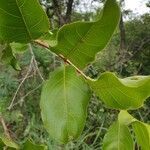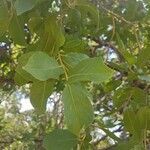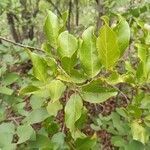Leaves opposite; lamina 3–13 x 1·5–7·5 cm., glutinous when young, broadly to narrowly obovate-elliptic or oblong-elliptic or ovate to sub-circular, lepidote (sometimes inconspicuously so) and pubescent or pilose to glabrous (except for scales), apex usually apiculate or mucronate and usually twisted, base usually rounded to subcordate; lateral nerves 5–7 pairs, ± arcuate, reticulation rather inconspicuous to prominulous beneath; petiole up to 10 mm. long, leaving a prominent peg.
A small tree. It loses its leaves during the year. It has several stems. The trunk is short and crooked. The bark is rough and dark grey. It cracks into a grid like pattern. The leaves are opposite. They are simple and broadly oval. The flowers are in spikes in the axils of leaves. They are small and creamy-yellow. The fruit has 4 wings. It is 20-30 mm long by 15-25 mm wide. It is yellowish green.
Scales yellowish-red, usually inconspicuous and often concealed by glutinous excretions, c. 45(50)–75(90)µ in diam., scalloped at each marginal cell; cells delimited by (7)8(10) radial walls and sometimes also up to 5 tangential walls and rarely with extra radial walls, marginal cells 7–10; cell-walls clear and thin, cells ± transparent.
Small semi-deciduous tree 4–10 m. high, rarely a shrub (doubtfully recorded as scandent); crown open, flattened to rounded; bark greyish-black, deeply fissured, scaly; branchlets tomentose to glabrous (except for scales), lepidote; leaf-buds black or dark-brown.
Fruit 2–3 x 1·5–2·5 cm., shiny (glutinous when young), subcircular to elliptic in outline, lepidote, otherwise glabrous or pubescent, apical peg up to 1 mm. long, wings up to 7 mm. broad, stipe 4–8 mm. long.
Lower receptacle 2 mm. long, lepidote and otherwise hairy or glabrous; upper receptacle 3–4 x 2·5–3 mm., campanulate, lepidote and otherwise glabrous or pubescent.
Inflorescences of axillary spikes 3–7 cm. long; rhachis lepidote and otherwise glabrous or hairy; bracts 1·5 x 0·3 mm., caducous.
Cotyledons 2, 2·5–2·8 x 3–4 cm., arising below soil level; petioles 4–5 cm. long.
Petals 1·2 x 1·2 mm., obtriangular, ciliate at the apex.
Stamen-filaments 5 mm. long, anthers 1·2–1·5 mm. long.
Style 5 mm. long, stout, not expanded at the apex.
Disk with a pilose scarcely free margin.
Sepals 0·5–1 mm. long, broadly deltate.
Flowers sessile, yellow.




